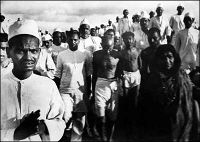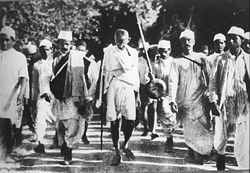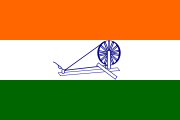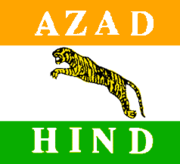Sarojini Naidu
| Sarojini Naidu | |
|---|---|
| Born | Sarojini Chattopadhyaya February 13, 1879 Hyderabad, Hyderabad State, British India |
| Died | March 2, 1949 (aged 70) Allahabad, Uttar Pradesh, India |
| Spouse(s) | Mr. Muthyala Govindarajulu Naidu |
| Children | Jayasurya, Padmaja, Randheer,nilawar and Leelamani |
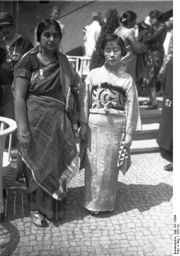
Sarojini Naidu (born as Sarojini Chattopadhyaya) (February 13, 1879, Hyderabad – March 2, 1949, Lucknow), also known by the sobriquet The Nightingale of India was a child prodigy, freedom fighter, and poet. Naidu was the first Indian woman to become the President of the Indian National Congress and the first woman to become the Governor of Uttar Pradesh.She was famously known as Bharatiya Kokila(The Nightingale of India).
She was active in the Indian Independence Movement, joining Mahatma Gandhi in the Salt March to Dandi, and then leading the Dharasana Satyagraha after the arrests of Gandhi, Abbas Tyabji, and Kasturba Gandhi.
Contents |
Early life
Sarojini Naidu was born in Hyderabad, India to a Hindu Brahmin family as the eldest daughter of scientist, philosopher, and educator Aghornath Chattopadhyaya, and Barada Sundari Devi, a poetess. Her father was the founder of the Nizam College, and also the first member of the Indian National Congress in Hyderabad with his friend Mulla Abdul Qayyum. He was later dismissed from his position as Principal and even banished in retaliation for his political activities. Sarojini was a excellent poet too.
Naidu's brother, Virendranath Chattopadhyaya, was also a noted Indian activist. During World War I Virendranath was instrumental in finding the Berlin Committee and was one of the leading figures of the Hindu German Conspiracy. He later became committed to Communism, travelling to Soviet Russia where he is believed to have been executed on Stalin's orders in 1937.
Another brother Harindranath Chattopadhyaya was a playwright, poet and actor.
Education
She passed her Matriculation examination from Madras University at the age of twelve, also being first in the entire Presidency. From 1891 to 1894 she took break from her studies and was involved in extensive reading on various subjects. In 1895, at the age of sixteen, she travelled to England to study first at King's College London and subsequently at Girton College, Cambridge.
Sarojini Naidu learnt to speak Urdu, Spanish, Telugu, English, Persian and Bengali. Her favorite poet was P.B. Shelley
In the Freedom struggle
She joined the Indian independence movement, in the wake of the aftermath of partition of Bengal in 1905. During 1903-17 Sarojini came into contact with Gopal Krishna Gokhale, Rabindranath Tagore, Muhammad Ali Jinnah, Annie Besant, C. P. Ramaswami Iyer, Mohandas Gandhi and Jawaharlal Nehru.
From 1915 to 1918 she lectured all over India on welfare of youth, dignity of labour, women's emancipation and nationalism. After meeting Jawaharlal Nehru in 1916, she took up the cause of the indigo workers of Champaran. In 1925 she was elected as the President of the Congress, the first Indian woman to hold the post.
In March 1919, the British government passed the Rowlatt Act by which the possession of seditious documents was deemed illegal. Mohandas Gandhi organized the Non-Cooperation Movement to protest and Naidu was the first to join the movement which the government worked to suppress.
In July 1919, Naidu became the Home Rule League's ambassador to England. In July 1920 she returned to India and on August 1, Mahatma Gandhi declared the Non-Cooperation Movement. In January 1924, she was one of the two Indian National Congress delegates at the East African Indian Congress.
Naidu arrived in New York in October 1928 and was concerned with the unjust treatment of the African Americans and the Amerindians. Upon her return to India she became a member of Congress Working Committee.
On January 26, 1930 the National Congress proclaimed its independence from the British Empire. On May 5, Mohandas Gandhi was arrested. Naidu was arrested shortly thereafter and was in jail for several months. She, along with Gandhi, was released on January 31, 1931. Later that year, they were again arrested. Naidu was eventually released due to her poor health and Gandhi was released in 1933. In 1931, she participated in the Round Table Summit, along with Gandhiji and Pundit Malaviyaji. On October 2, 1942, she was arrested during the "Quit India" protest and stayed in jail for 21 months with Gandhiji. Naidu shared a warm relationship with Mohandas Gandhi, even calling him "Mickey Mouse".
At the Asian Relations Conference of March 1947, Naidu presided over the Steering Committee.
On August 15, 1947, with the independence of India, Naidu became the Governor of the United Provinces (presently Uttar Pradesh), India's first woman governor and she died in office following a heart attack on March 2, 1949.
Personal life
At the age of 17, she met Dr. Muthyala Govindarajulu Naidu and fell in love with him. After finishing her studies at the age of 19, she married him during the time when inter-caste marriages were not allowed. They were married by the Act (1872), in Madras in 1898. They had 4 children: Jayasurya, Padmaja, Randheer, and Leelamani. Her daughter Padmaja later became Governor of Bengal.
Works
Each year links to its corresponding "[year] in poetry" article:
- 1905: The Golden Threshold, published in the United Kingdom[1] (text available online)
- 1912: The Bird of Time: Songs of Life, Death & the Spring, published in London[2]
- 1917: The Broken Wing: Songs of Love, Death and the Spring, including "The Gift of India" (first read in public in 1915)[3][2]
- 1943: The Sceptred Flute: Songs of India, Allahabad: Kitabistan, posthumously published[2]
- 1961: The Feather of the Dawn, posthumously published, edited by her daughter, Padmaja Naidu[4]
Quotes
Naidu writes: :Shall hope prevail where clamorous hate is rife,
- Shall sweet love prosper or high dreams have place
- Amid the tumult of reverberant strife
- 'Twixt ancient creeds, 'twixt race and ancient race,
- That mars the grave, glad purposes of life,
- Leaving no refuge save thy succoring face?
Naidu said, '"When there is oppression, the only self-respecting thing is to rise and say this shall cease today, because my right is justice."Naidu adds, "If you are stronger, you have to help the weaker boy or girl both in play and in the work."
References
- ↑ Knippling, Alpana Sharma, "Chapter 3: Twentieth-Century Indian Literature in English", in Natarajan, Nalini, and Emanuel Sampath Nelson, editors, Handbook of Twentieth-century Literatures of India (Google books link), Westport, Connecticut: Greenwood Publishing Group, 1996, ISBN 9780313287787, retrieved December 10, 2008
- ↑ 2.0 2.1 2.2 Vinayak Krishna Gokak, [http://books.google.com/books?id=WLE8GVsAfEMC&printsec=frontcover#v=onepage&q&f=false The Golden Treasury Of Indo-Anglian Poetry (1828-1965), p 313, New Delhi: Sahitya Akademi (1970, first edition; 2006 reprint), ISBN 8126011963, retrieved August 6, 2010
- ↑ Sisir Kumar Das, "A History of Indian Literature 1911-1956: Struggle for Freedom: Triumph and Tragedy", p 523, New Delhi: Sahitya Akademi (1995), ISBN 8172017987; retrieved August 10, 2010
- ↑ Lal, P., Modern Indian Poetry in English: An Anthology & a Credo, p 362, Calcutta: Writers Workshop, second edition, 1971 (however, on page 597 an "editor's note" states contents "on the following pages are a supplement to the first edition" and is dated "1972")
External links
- See images at Commons: commons:Category:Sarojini Naidu
- Works by Sarojini Naidu at Project Gutenberg
- Biography and Poems of Sarojini Naidu
- Letter written by Sarojini Naidu
- Biography of Sarojini Naidu
- First Biography of Muhammad Ali Jinnah by Sarojini Naidu (1917)
- Biography of Aghornath Chattopadhyaya
|
|||||||||||||||||
|
||||||||||||||||||||||||||||
